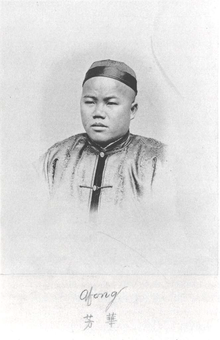Lai Afong
Appearance

Lai Afong (Chinese: 赖阿芳 aka. Lai Ah Fong, Huafang, Fang Lai, Lihua Fang, Li Fang, A'Fong Lai, 赖華芳, 黎華芳, 芳華) (c.1839 - 1890) was a Chinese photographer who established Afong Studio, one of the early photographic studios in Hong Kong. He is considered to be the most significant Chinese photographer of the nineteenth century.[1]
Work
His studio was active from 1859 to around the 1940s. The business was probably taken over by his son in the 1890s.[2] Subject matters ranged from portraits and social life pictures to cityscapes and landscapes. Lai's work and person were praised by John Thomson, a Scottish photographer working in China at the time, in Thomson's book The Straits of Malacca, Indo-China, and China.[3]
Gallery
Selected photographs by Lai Afong
-
Panorama of Gulangyu Island and Amoy
-
Canton commercial street view
See also
References
- ^ Hannavy, John (2013). Encyclopedia of Nineteenth-Century Photography. Routledge. p. 815. ISBN 9781135873264. Retrieved 10 September 2015.
- ^ "Afong" on Wattis Fine Art website
- ^ Thompson, John (1875). The Straits of Malacca, Indo-China, and China. Harper & brothers. pp. 188–189. Retrieved 11 November 2015.
Further reading
Wikimedia Commons has media related to Lai Afong.
- Bennett, Terry (2009). History of Photography in China 1842-1860. Bernard Quaritch. ISBN 978-0-9563012-0-8.
- Bennett, Terry (2013). History of photography in China : Chinese photographers, 1844-1879. London: Quaritch. ISBN 9780956301246.
- Chen, Shi (2009). Early Chinese Photographers from 1840 to 1870: Innovation and Adaptation in the Development of Chinese Photography (PDF) (Master of Arts thesis). University of Florida. Retrieved 26 February 2015.
- Cody, Jeffery W.; Terpak, Frances, eds. (2011). Brush & Shutter : early photography in China. Los Angeles, California: Getty Research Institute. ISBN 978-1-60606-054-4.







